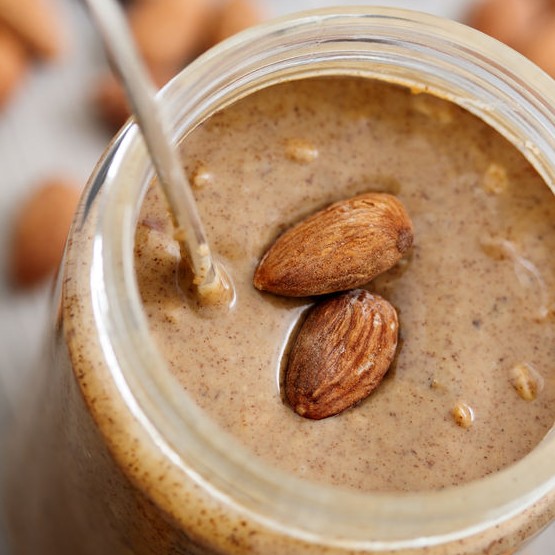
Almond Butter
What is Almond Butter
Almond butter is prepared by grinding shelled, blanched, unbalanced, raw or roasted almonds. It contains a minimum of 90% almonds.1 Ingredients, such as salt, honey, evaporated cane syrup, corn maltodextrin, flax seed, wheat germ, cocoa powder, cocoa butter, vanilla etc., may be added.1 Almond butter may also contain stabilizing ingredients such as, but not limited to, palm or peanut oil.1
Origin
Almond butter is the natural product. It is produced directly from almonds.
Nutrition
Table 1 Nutritional property of nut and seed butter (1 Tbsp):2
| Product | Calorie | Protein (g) | Fat | Calcium (mg) | Zinc (mg) |
|---|---|---|---|---|---|
| Almond Butter | 101 | 2.4 | 9.5 | 43 | 0.5 |
Table 2 Composition of raw and processed almonds per 100 g edible portion:2
| Raw Almonds | Roasted Almonds | Almond Butter | |
|---|---|---|---|
| Water (g) | 4.2 | 1.3 | 2.1 |
| Protein (g) | 25.3 | 25.4 | 24.6 |
| Total lipid (g) | 49.5 | 52.5 | 55.7 |
| MUFA (g) | 30.7 | 32.1 | 32.7 |
| PUFA (g) | 10.6 | 11.4 | 13.8 |
| SFA (g) | 3.5 | 3.7 | 3.9 |
| Carbohydrate (g) | 17.9 | 18.5 | 14.5 |
| Dietary Fiber (g) | 13.9 | 11.8 | 10.5 |
| Vitmin E (mg ATE) | 25.3 | 25.5 | 23.6 |
| Phytosterols (mg) | 113.6 | 125.8 | 145.1 |
| Sodium (mg) | <10 | 209 | <10 |
Almond butter contains generous amounts of phytochemicals that may be protective against colon, prostate, and breast cancer. Research shows that the relative risk of developing diabetes was reduced 27% in those who ate nuts five or more times per week compared with those who rarely or never ate nuts.2 Plant based diets high in raw or roasted almonds, or roasted almond butter helps lower cholesterol levels.3
Almond butter can be an alternative to peanut butter for those who are allergic to peanuts. It has significantly more fiber, calcium, potassium, iron, manganese, and vitamin E, and less saturated fat than peanut butter. Two tablespoons of almond butter provide ≥ 10% DV for protein, magnesium, phosphorus, manganese, and vitamin E.4
Among natural whole almonds, whole roasted almonds, chopped almonds and almond butter, almond butter has the highest metabolizable energy.5
Classification
Based on texture:1
- Smooth: Smooth almond butters shall have a very fine, very even texture with no perceptible grainy nut particles.
- Chunky/crunchy: Chunky/crunchy nut butters have a partially fine or partially grainy texture with a substantial amount of nut particles larger than 1/16 inch in any dimension.
Based on type:1
- Stabilized: The stabilized almond butter may contain suitable added ingredients to prevent oil separation. It exhibits no noticeable oil separation.
- non-stabilized: The non-stabilized nut butters require no more than slight mixing to disperse any separated oil.
Based on form:1
- Manufactured from roasted almonds: Almond butter produced from dry roasted almonds has a dark tan to light brown color with a freshly roasted almond odor and flavor.1
- Manufactured from dry almonds: Almond butter produced from raw almonds shall have a cream to light tan color with a sweet almond odor and flavor.1
Based on flavor:1
- Plain
- Chocolate
- Honey
- Maple
- Other
The difference between almond spread and almond butter is the spread refers to a spreadable product having at least 40% nut ingredients which can be added in various forms, e.g. as nuts, a paste and/or a slurry.2
FDA Regulation
FDA recalled some almond butter products due to their failure of declaring the possibility of containing peanut butter, for the benefit of those who might have allergies to peanut butter.6
References
- “Commercial Item Description: Nut Butters and Nut Spreads.” United States Department of Agriculture, 29 Aug. 2006. www.ams.usda.gov/sites/default/files/media/CID%20Nut%20Butters%20and%20Nut%20Spreads.pdf. 28 Feb. 2017.
- Gorrepati, Kalyani, S. Balasubramanian, and Pitam Chandra. “Plant Based Butters.” Journal of Food Science and Technology 52.7 (2014): 3965-976.
- Spiller, Gene A., Anna Miller, Karla Olivera, Julie Reynolds, Beverly Miller, Stanley J. Morse, Antonella Dewell, and John W. Farquhar. “Effects of Plant-Based Diets High in Raw or Roasted Almonds, or Roasted Almond Butter on Serum Lipoproteins in Humans.” Journal of the American College of Nutrition 22.3 (2003): 195-200.
- “Sunflower Seed Butter and Almond Butter as Nutrient-Rich Alternatives to Peanut Butter.” United States Department of Agriculture. www.ars.usda.gov/ARSUserFiles/80400525/Articles/ADA10_SunflowerAlmondButter.pdf. 28 Feb. 2017.
- Gebauer, Sarah K., Janet A. Novotny, Gail M. Bornhorst, and David J. Baer. “Food Processing and Structure Impact the Metabolizable Energy of Almonds.” Food Funct. 7.10 (2016): 4231-238.
- “Recalls, Market Withdrawals, & Safety Alerts – New Seasons Market Issues Allergy Alert on Undeclared Peanuts in Creamy Almond Butter.” U S Food and Drug Administration Home Page. Office of Regulatory Affairs, 13 Sept. 2016. www.fda.gov/Safety/Recalls/ucm520746.htm. Accessed 16 Mar. 2017.

